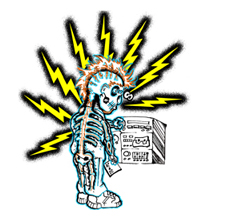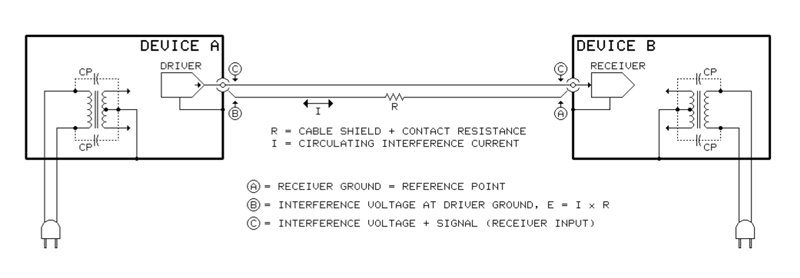
Because the interface is a series circuit, this noise voltage is directly added to the signal arriving at the receiver. We must accept this fact of life.
Because the grounded conductor is part of or “common” to both the signal and leakage current (noise) paths, this mechanism is called common impedance coupling. (Figure 3)
Consider a 25-foot interconnect cable with foil shield and a #26 AWG drain wire. The resistance of the shield (which usually, but not always, serves as grounded conductor) is found to be 1.0 Ohms. The resistance of the inner conductor is insignificant and not discussed here.
If the 60 Hz leakage current is 316 microamps (less than half the UL limit), the noise voltage will be 316 microvolts.
Because the -10 dBV reference level for consumer audio is 316 mV, the noise will be only 20 x log (316 microvolts/316 millivolts) equals -60 dB relative to the signal.
For most systems, this is a very poor signal-to-noise ratio.
Since the noise voltage developed is directly proportional to shield resistance, replacing the cable with Belden #8241F, for example, reduces shield resistance to 0.065 Ohms and reduces noise by about 24 dB! This is much better but still may be inadequate for high-performance systems.
If an unbalanced signal cable connects two pieces of equipment that are safety grounded (either directly or via other signal cables), noise coupling can become very severe.
Any ground voltage difference developed in the building wiring, which can range from a few millivolts to over a volt, is effectively connected across the ends of the cable shield.
Ground voltage differences may be even higher between the power grounding system and some other ground connection, such as a CATV (cable television) feed. The resulting hum can often be louder than a reference-level signal!
The Real Culprit
Based on this discussion, it should now be obvious that in most cases, the problem is not “dirty power” or “poor shielding” of cables. The most direct and effective solution is to find and eliminate the noise coupling where it actually happens.
As I’ve noted in previous columns, many technicians routinely and casually disconnect safety grounds to solve this kind of noise problem. But doing so can result in grave danger and devastating legal liability!
Bill Whitlock has served as president of Jensen Transformers for almost 29 years and is recognized as one of the foremost technical writers in professional audio.

